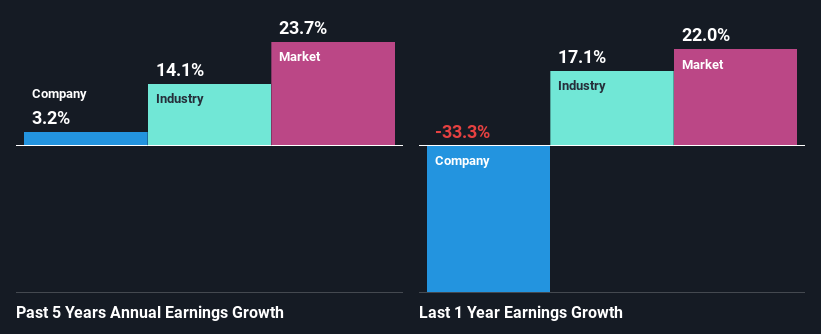KRBL Limited's (NSE:KRBL) Stock is Soaring But Financials Seem Inconsistent: Will The Uptrend Continue?

KRBL's (NSE:KRBL) stock is up by a considerable 7.5% over the past week. But the company's key financial indicators appear to be differing across the board and that makes us question whether or not the company's current share price momentum can be maintained. Particularly, we will be paying attention to KRBL's ROE today.
Return on equity or ROE is an important factor to be considered by a shareholder because it tells them how effectively their capital is being reinvested. In short, ROE shows the profit each dollar generates with respect to its shareholder investments.
View our latest analysis for KRBL
How Do You Calculate Return On Equity?
Return on equity can be calculated by using the formula:
Return on Equity = Net Profit (from continuing operations) ÷ Shareholders' Equity
So, based on the above formula, the ROE for KRBL is:
10% = ₹4.9b ÷ ₹49b (Based on the trailing twelve months to June 2024).
The 'return' is the profit over the last twelve months. One way to conceptualize this is that for each ₹1 of shareholders' capital it has, the company made ₹0.10 in profit.
What Has ROE Got To Do With Earnings Growth?
Thus far, we have learned that ROE measures how efficiently a company is generating its profits. Based on how much of its profits the company chooses to reinvest or "retain", we are then able to evaluate a company's future ability to generate profits. Assuming everything else remains unchanged, the higher the ROE and profit retention, the higher the growth rate of a company compared to companies that don't necessarily bear these characteristics.
KRBL's Earnings Growth And 10% ROE
At first glance, KRBL's ROE doesn't look very promising. Yet, a closer study shows that the company's ROE is similar to the industry average of 11%. We can see that KRBL has grown at a five year net income growth average rate of 3.2%, which is a bit on the lower side. Bear in mind, the company's ROE is not very high . So this could also be one of the reasons behind the company's low growth in earnings.
As a next step, we compared KRBL's net income growth with the industry and were disappointed to see that the company's growth is lower than the industry average growth of 14% in the same period.

Earnings growth is a huge factor in stock valuation. The investor should try to establish if the expected growth or decline in earnings, whichever the case may be, is priced in. This then helps them determine if the stock is placed for a bright or bleak future. If you're wondering about KRBL's's valuation, check out this gauge of its price-to-earnings ratio, as compared to its industry.
Is KRBL Making Efficient Use Of Its Profits?
KRBL's low three-year median payout ratio of 16% (or a retention ratio of 84%) should mean that the company is retaining most of its earnings to fuel its growth. However, the low earnings growth number doesn't reflect this fact. Therefore, there might be some other reasons to explain the lack in that respect. For example, the business could be in decline.
In addition, KRBL has been paying dividends over a period of at least ten years suggesting that keeping up dividend payments is way more important to the management even if it comes at the cost of business growth.
Summary
On the whole, we feel that the performance shown by KRBL can be open to many interpretations. Even though it appears to be retaining most of its profits, given the low ROE, investors may not be benefitting from all that reinvestment after all. The low earnings growth suggests our theory correct. Wrapping up, we would proceed with caution with this company and one way of doing that would be to look at the risk profile of the business. You can see the 1 risk we have identified for KRBL by visiting our risks dashboard for free on our platform here.
Valuation is complex, but we're here to simplify it.
Discover if KRBL might be undervalued or overvalued with our detailed analysis, featuring fair value estimates, potential risks, dividends, insider trades, and its financial condition.
Access Free AnalysisHave feedback on this article? Concerned about the content? Get in touch with us directly. Alternatively, email editorial-team (at) simplywallst.com.
This article by Simply Wall St is general in nature. We provide commentary based on historical data and analyst forecasts only using an unbiased methodology and our articles are not intended to be financial advice. It does not constitute a recommendation to buy or sell any stock, and does not take account of your objectives, or your financial situation. We aim to bring you long-term focused analysis driven by fundamental data. Note that our analysis may not factor in the latest price-sensitive company announcements or qualitative material. Simply Wall St has no position in any stocks mentioned.
About NSEI:KRBL
KRBL
Manufactures and markets rice products in India and internationally.
Flawless balance sheet established dividend payer.

